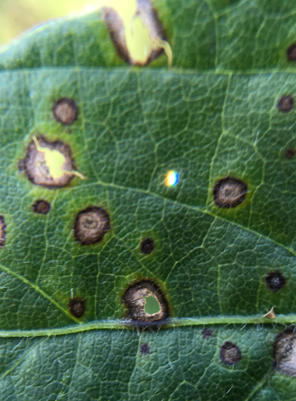 Frogeye leaf spot is a soybean disease commonly found across the United States, especially in Midwestern states such as Illinois, Iowa and Indiana. Caused by the fungus Cercospora sojina, the infection can cause up to 35% crop loss if left untreated.
Frogeye leaf spot is a soybean disease commonly found across the United States, especially in Midwestern states such as Illinois, Iowa and Indiana. Caused by the fungus Cercospora sojina, the infection can cause up to 35% crop loss if left untreated.
Symptoms — Small lesions appear on leaves early in the infection. Those lesions are circular in shape and gray with brown borders. As the disease progresses, lesions will start to appear on stems and pods.
Geography — The disease can be found across the United States and into parts of Canada. The pathogen is common in the southern United States. During most growing seasons, it is found in many Midwestern states, including Illinois, Iowa and Indiana.
Timing — Look for symptoms from May through September. Disease can occur at any time during the growing season.
Conditions for development — Frogeye leaf spot tends to develop during prolonged periods of dew and high humidity with warm temperatures between 75° F and 85° F.
Scouting tips — Spores are spread by wind and rain. Scout often, as lesions don’t start to appear on leaves until about two weeks after infection sets in. Plants are at highest risk after flowering.
Effect on yield — When conditions are right, up to 35% crop loss can occur because of the disease.
Management tips — Choose resistant soybean varieties with your retailer, rotate crops, till fields to encourage decomposition of infected residue, and apply a fungicide preventively or, if necessary, curatively. Aproach® Prima fungicide from Corteva Agriscience has two modes of action that provide excellent control of frogeye leaf spot.
™ ® Aproach® Prima is not registered for sale or use in all states. Contact your state pesticide regulatory agency to determine if a product is registered for sale or use in your state. Always read and follow label directions.